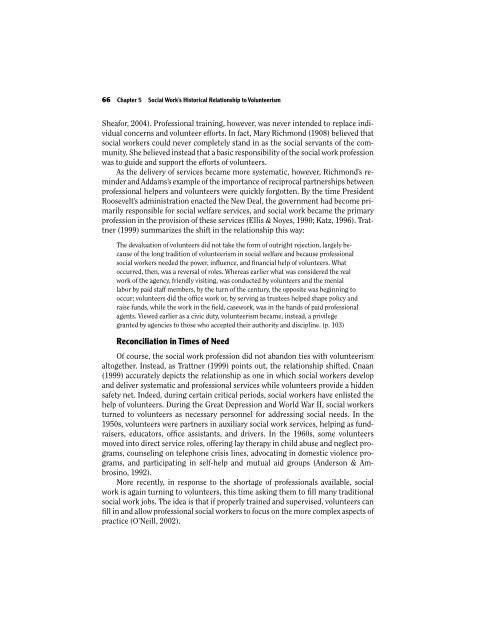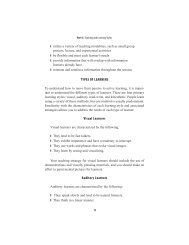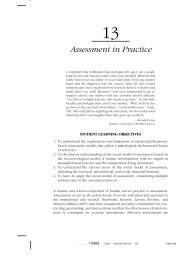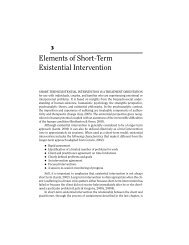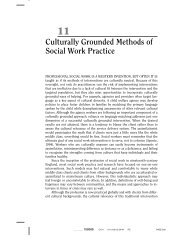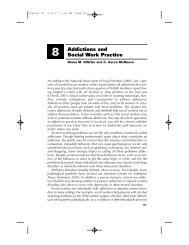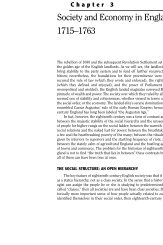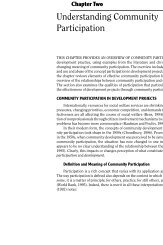Social Work's Historical Relationship to Volunteerism - Lyceum Books
Social Work's Historical Relationship to Volunteerism - Lyceum Books
Social Work's Historical Relationship to Volunteerism - Lyceum Books
Create successful ePaper yourself
Turn your PDF publications into a flip-book with our unique Google optimized e-Paper software.
66 Chapter 5 <strong>Social</strong> Work’s <strong>His<strong>to</strong>rical</strong> <strong>Relationship</strong> <strong>to</strong> <strong>Volunteerism</strong><br />
Sheafor, 2004). Professional training, however, was never intended <strong>to</strong> replace individual<br />
concerns and volunteer efforts. In fact, Mary Richmond (1908) believed that<br />
social workers could never completely stand in as the social servants of the community.<br />
She believed instead that a basic responsibility of the social work profession<br />
was <strong>to</strong> guide and support the efforts of volunteers.<br />
As the delivery of services became more systematic, however, Richmond’s reminder<br />
and Addams’s example of the importance of reciprocal partnerships between<br />
professional helpers and volunteers were quickly forgotten. By the time President<br />
Roosevelt’s administration enacted the New Deal, the government had become primarily<br />
responsible for social welfare services, and social work became the primary<br />
profession in the provision of these services (Ellis & Noyes, 1990; Katz, 1996). Trattner<br />
(1999) summarizes the shift in the relationship this way:<br />
The devaluation of volunteers did not take the form of outright rejection, largely because<br />
of the long tradition of volunteerism in social welfare and because professional<br />
social workers needed the power, influence, and financial help of volunteers. What<br />
occurred, then, was a reversal of roles. Whereas earlier what was considered the real<br />
work of the agency, friendly visiting, was conducted by volunteers and the menial<br />
labor by paid staff members, by the turn of the century, the opposite was beginning <strong>to</strong><br />
occur; volunteers did the office work or, by serving as trustees helped shape policy and<br />
raise funds, while the work in the field, casework, was in the hands of paid professional<br />
agents. Viewed earlier as a civic duty, volunteerism became, instead, a privilege<br />
granted by agencies <strong>to</strong> those who accepted their authority and discipline. (p. 103)<br />
Reconciliation in Times of Need<br />
Of course, the social work profession did not abandon ties with volunteerism<br />
al<strong>to</strong>gether. Instead, as Trattner (1999) points out, the relationship shifted. Cnaan<br />
(1999) accurately depicts the relationship as one in which social workers develop<br />
and deliver systematic and professional services while volunteers provide a hidden<br />
safety net. Indeed, during certain critical periods, social workers have enlisted the<br />
help of volunteers. During the Great Depression and World War II, social workers<br />
turned <strong>to</strong> volunteers as necessary personnel for addressing social needs. In the<br />
1950s, volunteers were partners in auxiliary social work services, helping as fundraisers,<br />
educa<strong>to</strong>rs, office assistants, and drivers. In the 1960s, some volunteers<br />
moved in<strong>to</strong> direct service roles, offering lay therapy in child abuse and neglect programs,<br />
counseling on telephone crisis lines, advocating in domestic violence programs,<br />
and participating in self-help and mutual aid groups (Anderson & Ambrosino,<br />
1992).<br />
More recently, in response <strong>to</strong> the shortage of professionals available, social<br />
work is again turning <strong>to</strong> volunteers, this time asking them <strong>to</strong> fill many traditional<br />
social work jobs. The idea is that if properly trained and supervised, volunteers can<br />
fill in and allow professional social workers <strong>to</strong> focus on the more complex aspects of<br />
practice (O’Neill, 2002).


